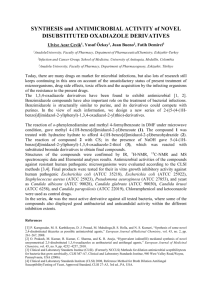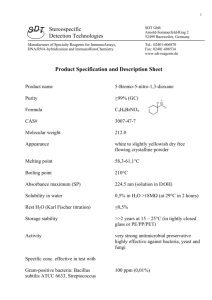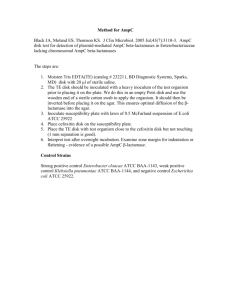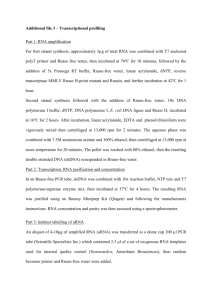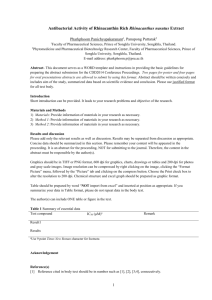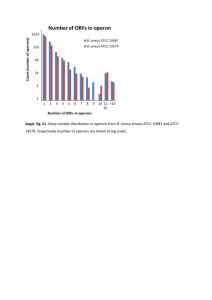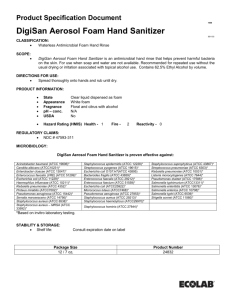Chemical Constituents and Antimicrobial Properties of the
advertisement
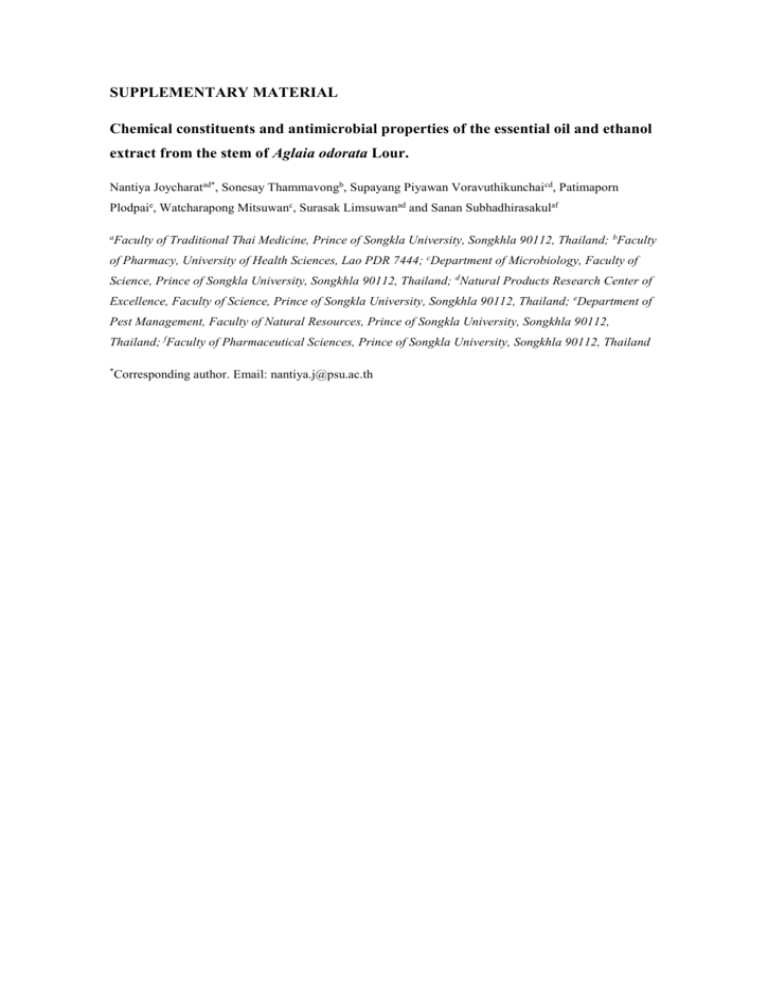
SUPPLEMENTARY MATERIAL Chemical constituents and antimicrobial properties of the essential oil and ethanol extract from the stem of Aglaia odorata Lour. Nantiya Joycharatad*, Sonesay Thammavongb, Supayang Piyawan Voravuthikunchaicd, Patimaporn Plodpaie, Watcharapong Mitsuwanc, Surasak Limsuwanad and Sanan Subhadhirasakulaf a Faculty of Traditional Thai Medicine, Prince of Songkla University, Songkhla 90112, Thailand; bFaculty of Pharmacy, University of Health Sciences, Lao PDR 7444; cDepartment of Microbiology, Faculty of Science, Prince of Songkla University, Songkhla 90112, Thailand; dNatural Products Research Center of Excellence, Faculty of Science, Prince of Songkla University, Songkhla 90112, Thailand; eDepartment of Pest Management, Faculty of Natural Resources, Prince of Songkla University, Songkhla 90112, Thailand; fFaculty of Pharmaceutical Sciences, Prince of Songkla University, Songkhla 90112, Thailand * Corresponding author. Email: nantiya.j@psu.ac.th Abstract The stem-derived essential oil of Aglaia odorata Lour was obtained by hydrodistillation using a Clevenger type system. Gas chromatographymass spectrometry analysis of the oil revealed the identification of 39 compounds, representing 76.4% of the oil; germacrene D (20.3%), -humulene (17.1%), -himachalene (12.7%), and -caryophyllene (10.2%) were the major components. Ar-turmerone (1) and eichlerialactone (2) were isolated from the stem oil and ethanolic stem extract of this plant species, respectively. Antimicrobial activities of the oil and ethanol extract were tested against both Gram-positive and Gram-negative bacterial strains including Bacillus cereus ATCC 11778, Staphylococcus aureus ATCC 25923, Acinetobacter baumannii ATCC 19606, and Escherichia coli ATCC 25922, as well as three rice fungal pathogens Bipolaris oryzae, Pyricularia oryzae, and Rhizoctonia solani using broth microdilution method. The oil and 1 exhibited significant antifungal activity against the three rice pathogens tested whereas 2 exhibited good antibacterial activity against both of Gram-positive pathogens tested. Keywords: Aglaia odorata; antimicrobial activity; ar-turmerone; essential oil; rice pathogens Experimental General experimental procedures GCMS analysis of the oil was carried out using Agilent 7890A GC (Agilent 21 Technologies, USA) coupled with Pegasus 4D time-of-flight mass spectrometer (LECO Corp, USA). 1D and 2DNMR spectral data were recorded on FTNMR Bruker Advance 500 MHz. EIMS was performed on MAT 95 XL mass spectrometer (Thermofinigan, Germany). The following pathogenic microorganisms were used: two Gram-positive bacteria (Bacillus cereus ATCC 11778 and Staphylococcus aureus ATCC 29213), two Gram-negative bacteria (Acinetobacter baumannii ATCC 19606 and Escherichia coli ATCC 25922) and three fungi isolated from rice (Bipolaris oryzae, Pyricularia oryzae, and Rhizoctonia solani). Pathogens used in this work were obtained both from Department of Microbiology and Natural Products Research Center of Excellence, Faculty of Science and Department of Pest Management, Faculty of Natural Resources, Prince of Songkla University, Thailand. Plant material The stem of Aglaia odorata Lour was collected from the southern region of Thailand in May 2011. Botanical identification was performed by Dr. Oratai Neamsuvan, an ethnobotanist at the Faculty of Traditional Thai Medicine, Prince of Songkla University, where the voucher specimen (NJ0511) is deposited. Extraction of the oil and isolation The stem of A. odorata was dried in an oven at 60 C. The dried stem (800 g) was ground and hydrodistilled for 8 h using a Clevenger-type apparatus. The essential oil was collected, dried over anhydrous sodium sulphate, and stored at 4 °C until used. The percentage yield of the oil recovered was calculated based on the dried weight of plant material. For the compound isolation, the oil (1.5 g) was applied to column chromatography over silica gel using gradient elution with ethyl acetate (EtOAc)petroleum ether, and finally washed down with methanol (MeOH). The fractions were then combined according to their TLC patterns, to give fourteen fractions (IO–XIVO). Fraction VIO (142 mg) was further purified using a Preparative thin layer chromatography with 3% EtOAc in toluene as the developing solvent to afford 4.9 mg of ar-turmerone (1) (Figure S1). Gas chromatographymass spectrometry (GCMS) The essential oil from A. odorata was analysed using GCMS on Agilent 7890A GC equipped with Pegasus 4D time-of-flight mass spectrometer. The separation condition was carried out on Rxi-5silMS capillary column (30 m x 0.25 mm i.d., film thickness 0.25 m). Column temperature was initially kept at 50 C for 2 min, and gradually increased at the rate of 5 C per min to 245 C, at which the temperature was held for 8 min; split ratio was 1:400; injector temperature was 257 C. Helium was used as carrier gas at a flow rate of 1 ml/min. The sample of 1 l was injected in the acquisition mode. For MS detection, an electron ionization system with ionization energy of 70 eV with MS transfer line at temperature of 250 C was used. The scan range was 35334 amu and the scan rate was 0.5 s per scan. The retention indices (RI) of all the components were determined by co-injection of the sample with a solution containing C7C36 n-alkanes standards. Identification of the individual components was based on the comparison of their GC retention indices and mass spectra with those of published data (Adams, 2001) and National Institute of Standards and Technology mass spectra library (NIST2.0) data of GCMS system. Quantification was based on the percentage contribution of each oil components to the total amount present. Preparation of ethanol extract and isolation The plant materials were rinsed thoroughly and cleaned from extraneous matter with tap water, ovendried at 60 C, grounded with an electric-grinder, weighed, and exhaustively macerated with 95% EtOH at room temperature 3 times. The filtrate was pooled and concentrated under reduced pressure at 45 C in vacuum rotary evaporator to give the EtOH extract. For the phytochemical isolation, the EtOH extract was partitioned with various solvents ordered by increasing polarity. Each filtrate was pooled and evaporated to dryness under reduced pressure at 45 ºC to yield the hexane fraction, CH2Cl2 fraction, and BuOH fraction. The CH2Cl2 fraction (2.15 g) was applied to CC over silica gel using gradient elution with acetone–hexane, and finally washed down with MeOH. The fractions were then combined according to their TLC patterns, to give seven fractions (ID–VIID). Fraction VD (259 mg) was further purified on a silica gel column with 20% acetone in hexane as the eluent and followed by a Sephadex LH20 column eluting with CH2Cl2–MeOH (1:1) to afford 4.1 mg of eichlerialactone (2) (Figure S1). ar-Turmerone (1). yellow oil; EIMS (70 eV, 200 C): m/z = 91, 119, 132, 149, 178, 216; 13C NMR (125 MHz, CDCl3): 135.5 (s, C-1), 129.1 (d, C-2), 126.6 (d, C-3), 143.7 (s, C-4), 126.6 (d, C-5), 129.1 (d, C-6), 35.2 (d, C-7), 52.7 (t, C-8), 199.9 (s, C-9), 124.1 (d, C-10), 155.1 (s, C-11), 27.6 (q, C-12), 20.7 (q, C-13), 21.9 (q, C-14), 20.9 (q, C-15). Eichlerialactone (2). Colorless solid; 13C NMR (125 MHz, CDCl3): 24.5 (t, C-1), 28.2 (t, C-2), 178.1 (s, C-3), 147.3 (s, C-4), 41.0 (d, C-5), 31.2 (t, C-6), 33.7 (t, C-7), 40.0 (s, C-8), 49.3 (d, C-9), 39.0 (s, C-10), 21.9 (t, C-11), 25.0 (t, C-12), 43.2 (d, C-13), 50.5 (s, C-14), 31.4 (t, C-15), 26.7 (t, C-16), 50.7 (d, C-17), 15.3 (q, C-18), 20.1 (q, C-19), 89.8 (s, C-20), 22.4 (q, C-21), 29.2 (t, C-22), 34.1 (t, C-23), 176.8 (s, C-24), 113.5 (t, C-28), 23.1 (q, C-29), 16.1 (q, C-30). Antimicrobial activity Microbial strains including Bipolaris oryzae, Pyricularia oryzae, Rhizoctonia solani, Bacillus cereus ATCC 11778, Staphylococcus aureus ATCC 25923, Acinetobacter baumannii ATCC 19606, and Escherichia coli ATCC 25922 were used in this investigation. Mueller Hinton agar (Difco Laboratories, USA), Mueller Hinton broth (MHB) (Difco Laboratories, USA), Potato dextrose agar (Difco Laboratories, USA) and Roswell Park Memorial Institute (RPMI) 1640 medium (Sigma-Aldrich, USA) were used as culture media. Standard drugs including penicillin G and propiconazole were used as positive controls for Gram-positive bacterial and fungal cultures, respectively. DMSO (1% v/v) was used as negative control. Antimicrobial activity of essential oil, ethanol extract, and isolated compounds from A. odorata stem was examined by broth microdilution assay using MHB for bacterial strains (CLSI, 2009) and RPMI 1640 medium for fungal strains (CLSI, 2008). Two fold serial dilutions of the tested agents were prepared in 96-well microtiter plates in the respective medium to final concentration ranged from 0.0019 to 2 mg mL-1. The microbial suspensions in the respective test medium were standardized to McFarland No. 0.5. Twenty microliters of microbial suspension was added to each well of the plate, resulting in a final inoculums concentration of 5 x 10 5 CFU mL-1. The microbial growth was determined at 24 h of incubation by spectrophotometric mean at 600 nm. The lowest concentration of the tested agents required to completely inhibit microbial growth after incubation at 37 C for 24 h for bacteria or at 25 C for 2472 h for fungi was recorded as minimum inhibitory concentration (MIC). After MICs were recorded, an aliquot (100 µl) from the broth with no growth was pipetted and dropped onto agar plate and incubated with at 37 °C for 48 h for bacteria or at 25 C for 72 h for fungi. The lowest concentration of the tested agents required to completely preventing microbial growth was reported as minimum bactericidal concentration (MBC) for bacteria or minimum fungicidal concentration (MFC) for fungi. Each assay was performed in triplicate. Table S1. Composition of the stem essential oil of Aglaia odorata Lour. Compounds Benzaldehyde 6-Methyl-5-hepten-2-one β-Pinene Camphor Borneol Bezoic acid, 2-(acetyloxy)-, methyl ester (E,E)-2,4-Decadienal α-Ylangene α-Copaene β-Cubebene β-Elemene Longifolene -Caryophyllene -Elemene trans-α-Bergamotene (E)-β-Farnesene -Himachalene -Humulene Acoradiene γ-Gurjunene ar-Curcumene Germacrene D -Zingiberene β-Bisabolene -Cadinene δ-Amorphene trans-Calamenene Spathulenol Viridiflorol Humulene epoxide II Khusimone γ-Eudesmol α-Cadinol ar-Turmerone RIa 954 972 979 1142 1160 1187 1310 1367 1379 1382 1400 1405 1417 1427 1442 1447 1456 1462 1467 1472 1481 1486 1493 1502 1515 1518 1530 1578 1593 1596 1599 1632 1639 1660 Peak area (%) tb t t t t t t 1.8 t 0.7 0.1 0.5 10.2 0.8 1.3 0.1 12.7 17.1 4.5 0.1 0.3 20.3 t 2.1 0.2 0.5 t 0.1 0.1 0.1 0.1 0.1 0.1 2.3 Identification MS, RI MS MS, RI MS, RI MS, RI MS MS MS, RI MS, RI MS, RI MS, RI MS, RI MS, RI MS, RI MS, RI MS, RI MS, RI MS, RI MS, RI MS, RI MS, RI MS, RI MS, RI MS, RI MS, RI MS, RI MS, RI MS, RI MS, RI MS, RI MS, RI MS, RI MS, RI MS, RI, 1D& 2D NMR MS, RI MS, RI MS, RI MS MS α-Bisabolol 1671 0.1 Vitiselinenol 1729 0.1 Cyclohexadecanolide 1934 0.1 1,3-Bis-(2-cyclopropyl,2-methylcyclopropyl)-but-2-en-1-one 1981 t 9,12,15-Octadecatrienoic acid methyl ester 2269 0.1 Monoterpene hydrocarbons t Sesquiterpene hydrocarbons 73.1 Oxygenated sesquiterpenes 3.1 Others 0.2 Total amount identified (%) 76.4 Essential oil yield (% ) 0.07 a Retention indices relative to C7C36 n-alkanes on a Rxi-5silMS capillary column. bTrace ( 0.1%). Table S2. Antimicrobial activity of essential oil (EO), ethanol extract (EE), ar-turmerone (1), and eichlerialactone (2) from Aglaia odorata stem. Pathogenic microorganisms Gram-positive bacteria Bacillus cereus ATCC 11778 Staphylococcus aureus ATCC 25923 Gram-negative bacteria Acenetobacter baumannii ATCC 19606 Escherichia coli ATCC 25922 Rice fungi Bipolaris oryzae Pyricularia oryzae Rhizoctonia solani MICa (MBCb or MFCc ) (mg mL-1) 1 2 EO EE Controls 2.0 (2.0) 2.0 (2.0) 2.0 (2.0) 2.0 (2.0) 0.25 (0.25) 0.25 (0.25) 0.25 (0.25) 0.5 (1.0) 0.0002 (0.0002) 0.0002 (0.0002) 2.0 (2.0) 2.0 (2.0) 2.0 (2.0) 2.0 (2.0) Nd Nd Nd Nd 0.50 (1.0) 0.0625 (0.25) 0.25 (0.25) 2.0 (2.0) 1.0 (2.0) 2.0 (>2.0) 0.25 (>0.25) 0.0625 (0.25) 0.125 (0.25) 1.0 (2.0) 0.25 (0.25) 1.0 (>2.0) 0.0002 (0.0002) 0.0002 (0.0002) 0.0019 (0.0019) Note: Controls used are already mentioned in experimental section. aMinimum inhibitory concentration; b Minimum bactericidal concentration; cMinimum fungicidal concentration. Nd: Not determined; : No inhibitory effect (1% DMSO). O O H HOOC O 1 2 Figure S1. Antimicrobial compounds isolated from the stem of Aglaia odorata Lour. References Adams, R.P. (2001). Identification of essential oil components by Gas Chromatography/Mass Spectroscopy. Allured Publishing Corporation, Carol Stream, IL. Clinical and Laboratory Standards Institute (CLSI). (2008). Reference Method for Broth Dilution Antifungal Susceptibility Testing of Filamentous Fungi, Approved Standard, 2 nd ed. CLSI Document M38-A2, Clinical and Laboratory Standards Institute, Wayne, Pennsylvania. Clinical and Laboratory Standards Institute (CLSI). (2009). Methods for Dilution Antimicrobial Susceptibility Tests for Bacteria That Grow Aerobically, Approved Standard, 8 th ed. CLSI Document M07-A8, Clinical and Laboratory Standards Institute, Wayne, Pennsylvania.
